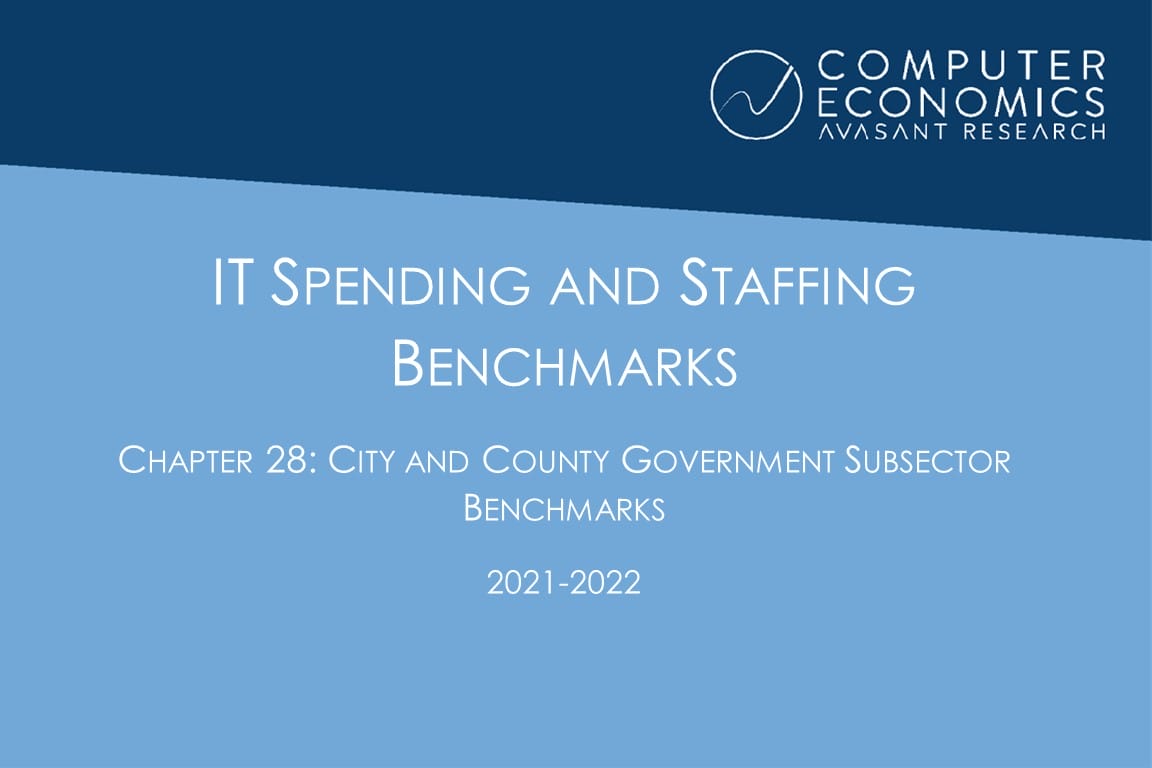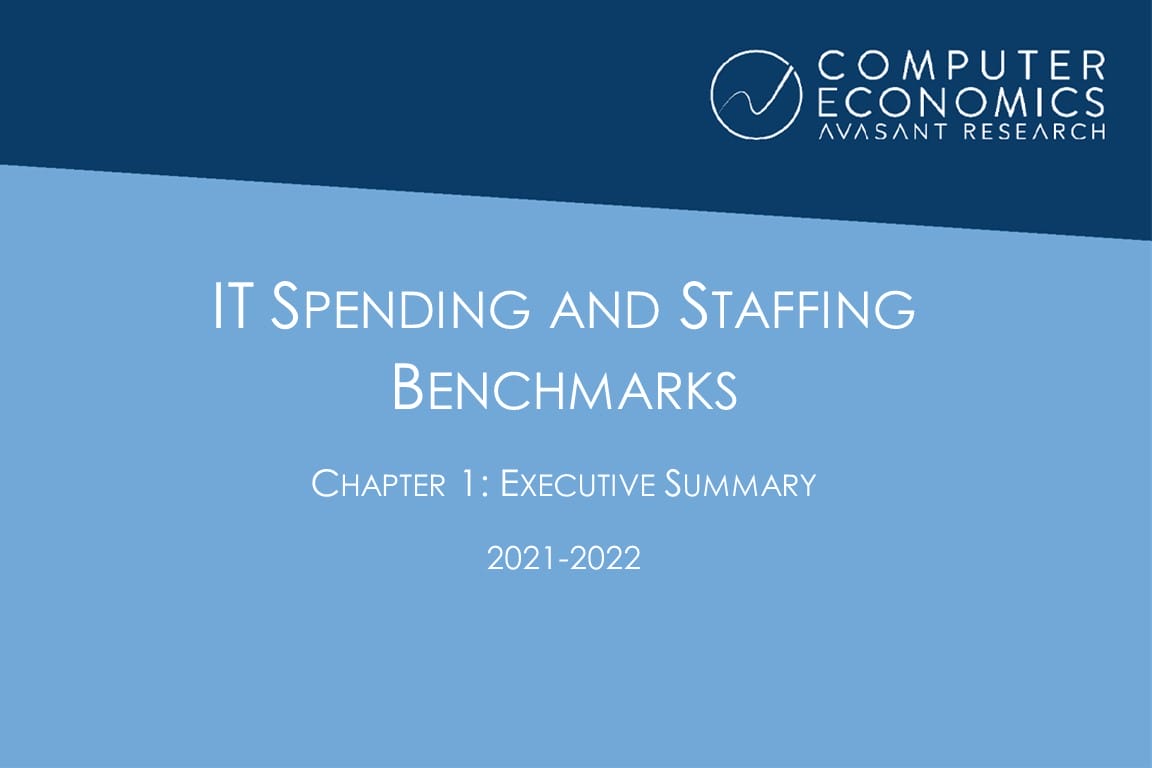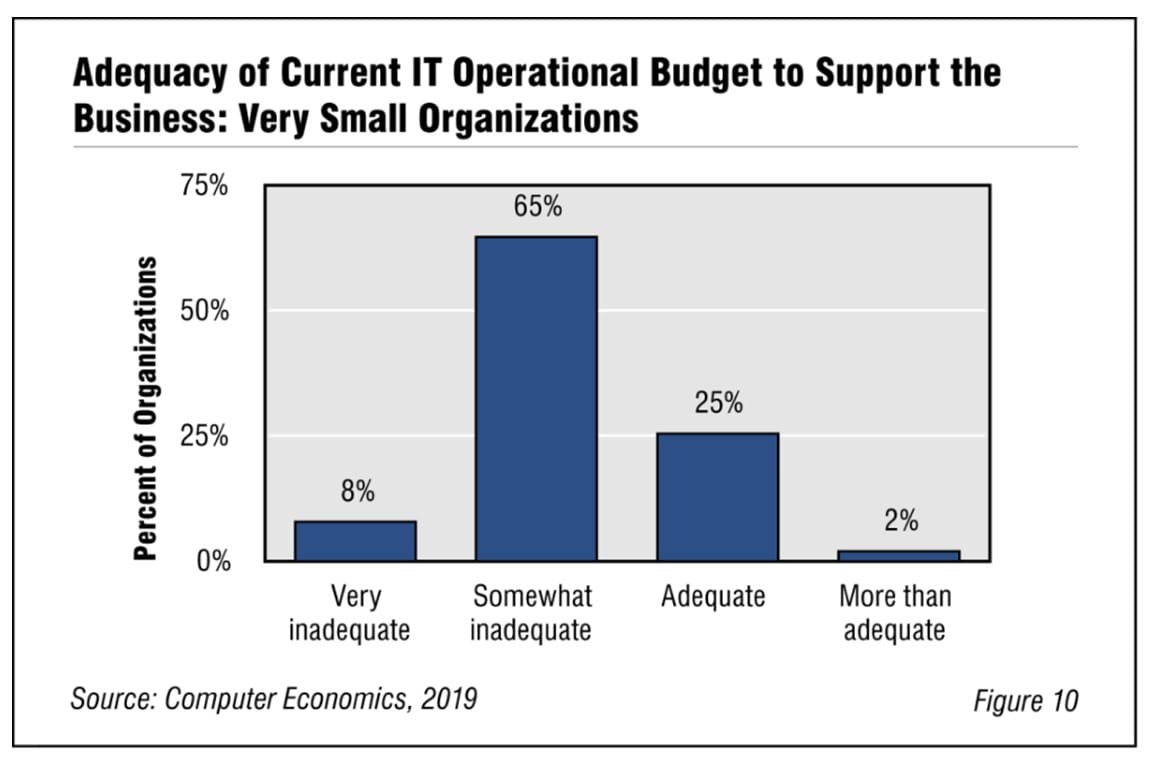Latest Reports
-
![IT Spending and Staffing Benchmarks 2021/2022: Chapter 26: Online Retail Subsector Benchmarks ISSCh26 - IT Spending and Staffing Benchmarks 2021/2022: Chapter 26: Online Retail Subsector Benchmarks]()
IT Spending and Staffing Benchmarks 2021/2022: Chapter 26: Online Retail Subsector Benchmarks
Chapter 26 provides benchmarks for utilities. The 16 respondents in this subsector range in size from $100 million to $26.8 billion in annual revenue. This category includes gas and electric utilities, power transmission distributors, water and power utilities, and telecommunications service providers.
July, 2021
-
![IT Spending and Staffing Benchmarks 2021/2022: Chapter 27: Hospital Subsector Benchmarks ISSCh27 - IT Spending and Staffing Benchmarks 2021/2022: Chapter 27: Hospital Subsector Benchmarks]()
IT Spending and Staffing Benchmarks 2021/2022: Chapter 27: Hospital Subsector Benchmarks
Chapter 27 provides benchmarks for hospitals. The 36 respondents in this subsector range in size from $95 million to around $9 billion in annual revenue. This category includes community hospitals, university hospitals, nonprofit hospitals, health clinics, healthcare systems, and regional healthcare providers.
July, 2021
-
![IT Spending and Staffing Benchmarks 2021/2022: Chapter 28: City and County Government Subsector Benchmarks ISSCh28 - IT Spending and Staffing Benchmarks 2021/2022: Chapter 28: City and County Government Subsector Benchmarks]()
IT Spending and Staffing Benchmarks 2021/2022: Chapter 28: City and County Government Subsector Benchmarks
Chapter 28 provides benchmarks for city and county governments. This chapter is concerned with the IT workings of city or county governments and not individual agencies within larger governments (which can be found in Chapter 29). The 25 respondents in this subsector have annual operating budgets ranging from $50 million to $68 billion.
July, 2021
-
![IT Spending and Staffing Benchmarks 2021/2022: Chapter 29: Government Agencies Subsector Benchmarks ch292021 - IT Spending and Staffing Benchmarks 2021/2022: Chapter 29: Government Agencies Subsector Benchmarks]()
IT Spending and Staffing Benchmarks 2021/2022: Chapter 29: Government Agencies Subsector Benchmarks
Chapter 29 provides benchmarks for federal, state, and regional government agencies. The category includes public health agencies, courts and law enforcement agencies, organizations that provide IT services to government agencies, social service agencies, state parks, lotteries, and other federal, state, and regional government units. The 24 respondents in the sample have operating budgets that range in size from $62 million to about $40 billion.
July, 2021
-
![IT Spending and Staffing Benchmarks 2021/2022: Chapter 30: Logistics Subsector Benchmarks ISSCh30 - IT Spending and Staffing Benchmarks 2021/2022: Chapter 30: Logistics Subsector Benchmarks]()
IT Spending and Staffing Benchmarks 2021/2022: Chapter 30: Logistics Subsector Benchmarks
Chapter 30 provides benchmarks for logistics providers. The 17 respondents in this sample range in size from $52 million to about $52 billion. The sector is comprised of logistics companies that transport goods, including refined petroleum distributors, national moving or courier companies, freight transportation companies, supply chain logistics providers, and other logistics companies.
July, 2021
-
![IT Spending and Staffing Benchmarks 2021/2022: Chapter 31: Higher Education Subsector Benchmarks ISSCh31 - IT Spending and Staffing Benchmarks 2021/2022: Chapter 31: Higher Education Subsector Benchmarks]()
IT Spending and Staffing Benchmarks 2021/2022: Chapter 31: Higher Education Subsector Benchmarks
Chapter 31 provides benchmarks for higher-education institutions. The sector includes public and private colleges and universities, business and medical schools, and for-profit institutions. The 20 respondents in the sample have annual revenues ranging in size from about $50 million to about $1.7 billion.
July, 2021
-
![IT Spending and Staffing Benchmarks 2021/2022: Chapter 1: Executive Summary ISSCh01 - IT Spending and Staffing Benchmarks 2021/2022: Chapter 1: Executive Summary]()
IT Spending and Staffing Benchmarks 2021/2022: Chapter 1: Executive Summary
Chapter 1 of our 2021/2022 IT Spending and Staffing Benchmarks study provides a detailed analysis of the major findings from this year's study. It also describes the contents of the subsequent chapters, and gives detailed information about the demographics of the study participants and the survey methodology.
July, 2021
-
![IT Spending and Staffing Benchmarks 2020-2021: Full Study ISS2020 21Fullstudy - IT Spending and Staffing Benchmarks 2020-2021: Full Study]()
IT Spending and Staffing Benchmarks 2020-2021: Full Study
Our IT Spending and Staffing Benchmarks study for 2020/2021 provides a comprehensive view of the current state of IT budgeting and staffing levels for business and governmental organizations in the U.S. and Canada, based on our 31st annual survey. Detailed metrics are provided by organization size and by industry sector.
July, 2020
-
![The Mandate for Growing IT Spending in the Insurance Industry InsFig1 - The Mandate for Growing IT Spending in the Insurance Industry]()
The Mandate for Growing IT Spending in the Insurance Industry
Insurance providers are at a crossroads. Many have large, complex legacy systems deeply embedded in back-end processes. These require legions of IT personnel to keep them responsive to changing market needs. Now, these established players face new competitive threats from upstarts, unencumbered by legacy systems, able to rethink how insurance services can be delivered to customers in new ways. At the same time, the coronavirus pandemic has thrown a monkey wrench into strategic planning in the insurance industry.
October, 2021
-
![Long-Term Trends in IT Spending and the Impact of the Cloud FigLongtermITspenidngRB - Long-Term Trends in IT Spending and the Impact of the Cloud]()
Long-Term Trends in IT Spending and the Impact of the Cloud
Corporate IT spending varies from year to year as the economy expands and contracts: these are the cyclical trends. But over longer periods, IT spending also changes based on shifts in technology: these are secular trends. What are the secular trends that are currently affecting IT spending, especially those brought about by greatest recent shift in technology: cloud computing? This report examines the 11-year trend in spending for application software, IT personnel, data centers, networking, and other categories, and how cloud computing is changing that mix.
March, 2018
-
![IT Spending Benchmarks for Very Small Organizations 2019-2020 Fig1VerysmallOrgRB - IT Spending Benchmarks for Very Small Organizations 2019-2020]()
IT Spending Benchmarks for Very Small Organizations 2019-2020
For the first time, Computer Economics has conducted a study on the IT spending habits of “very small” organizations in the U.S. and Canada, a population that is beneath the size threshold for our annual IT spending and staffing benchmark study. This report examines high-level IT spending, staffing metrics and trends for such very small IT organizations. We further break down the high-level metrics by three sectors: manufacturing, retail and wholesale distribution; professional and technical services; and financial services. To qualify as very small for the purposes of this study, a company has to be either under $50 million in revenue or under $1 million in IT operational spending. (36 pp., 17 fig.)
November, 2019
-
![Worldwide IT Spending and Staffing Outlook for 2020 Fig1WorldwideITSpendingandStaffingOutlookfor2020 - Worldwide IT Spending and Staffing Outlook for 2020]()
Worldwide IT Spending and Staffing Outlook for 2020
Although IT leaders worldwide have a positive outlook for the global economy, that outlook seems a bit tinged with frustration compared to previous years. This report, based on our Q4 survey, provides data on the global and U.S./Canadian trends for IT spending and staffing in 2020. This year, our report assesses IT operational and capital spending plans, executive priorities for IT investment, and plans for hiring, outsourcing, and pay raises for IT organizations worldwide and in the U.S. and Canada. (34 pp., 24 fig.)
January, 2020



















